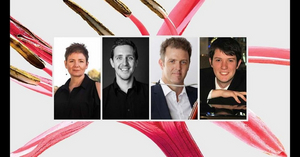 Reviewed by Ewart Shaw, Thursday August 26th 2021
Reviewed by Ewart Shaw, Thursday August 26th 2021
Australia's, nay, one of the world's most influential purveyors of chamber music, Musica Viva, has been dancing deftly around the lockdowns and border closures that have played musical chairs with their 2021 concert schedule. Introducing this concert,
French Wind Music, a late replacement for a Sydney-based ensemble, Musica Viva representative,
Emily Kelly, paid warm thanks to the four local musicians who had taken that place on the stage of the Adelaide Town Hall.
Dean Newcombe is principal clarinet with the Adelaide Symphony Orchestra, Mark Gaydon is principal bassoon, and Celia Craig was, until recently, principal oboe. With their associate artist, pianist Michael Ierace, they performed a program of music for wind instruments by French composers of the 19th and 20th centuries. None of the works was particularly lengthy and, indeed, the concert could be seen as a grazing table of delicious pieces, including some tasty soufflés.
The coordination of the three wind soloists was impeccable, and no more so than in the long and rapid passages that characterise so much of the writing. I grew up believing that a sonata needed a piano. Now I know it doesn't.
The four short movements of the
Divertissement of Jean Francaix (1912-1997) which opened the concert was rightly described by Craig as "zany", and that energy informed several of the pieces that were played. Scored for oboe, clarinet, and bassoon, it began with an elegant Prelude before the jaunty Allegretto Assai, and after a brief Elegie, it launched into a delightful Scherzo that went at great speed.
For the oboe sonata of Camille Saint-Saens (1835-1921), Craig was joined by Michael Ierace. I first encountered this work when the two of them presented a concert in the SANTOS Museum of Economic Botany as part of the Adelaide Botanic Gardens Botanica Lumina project. Craig has recorded it under her own Artaria label, with Konstantin Shamray. I bought the album.
This was followed by the
Sonata for Clarinet and Bassoon, by
Francis Poulenc (1889-1963). The bassoon has a reputation as the joker of the orchestra and, as the work begins, it's huffing out a staccato accompaniment to the lithe clarinet
Melody But, in Gaydon's hands, it's a lively participant to Newcomb's lyricism. Gaydon was particularly impressive in the trio for oboe, bassoon, and piano. It's an energetic workout for all the players, and impressively delivered.
I'm trying to track down a recording of the Paul Pierne ( 1874-1952)
Bucolique Variations, another excellently crafted work for woodwind. Paul is the cousin of the slightly better know, Gabriel Pierne. It's proving equally difficult to locate the
Sonata Champetre of Germaine Tailleferre (1892-1983). She was the only woman included in that loose association of French composers known as Les Six. While the title harks back to the French baroque and rococo, imagine the paintings of Watteau, her musical textures set this work apart from the other composers in this program.
Early in the concert, Craig spoke of her synaesthesia. Simply put, when she hears or plays a note of music she also sees a colour accompanying it. Neurodiversity is a wonderful thing, and I experienced something similar during the concert. Michael Ierace played two short pieces by Eric Satie (1866-1925). Satie loved odd titles for his works such as the
Sonatine Bureaucratique, but he also created new musical forms. You know the
Gymnopedies, but he created a set of
Gnossiennes, and Ierace chose to play the third. Nobody's quite sure what Satie had in mind, but the pieces are unbarred, leaving a great deal to the pianist. His instructions are also surreal. At one point the pianist is instructed to arm themselves with clairvoyance. Listening, though, to this short work in Ierace's hands, I was transported back to a temple, a religious ceremony, I could see purple and was aware of the scent of incense. Wherever and whenever that was, I was really pleased to be taken there.
I was thinking later about the fact that a string quartet can sit and play for forty-five minutes, as can a pianist with a Beethoven sonata or two, but these musicians play standing up, and the immense diaphragm pressure required to produce tuneful noises from what are, after all, highly complex pieces of plumbing, is particularly demanding on the human frame. That they are still standing, and smiling, at the end of the concert is a tribute to their training and stamina.
Reader Reviews
To post a comment, you must
register and
login.
 Reviewed by Ewart Shaw, Thursday August 26th 2021
Reviewed by Ewart Shaw, Thursday August 26th 2021 Reviewed by Ewart Shaw, Thursday August 26th 2021
Reviewed by Ewart Shaw, Thursday August 26th 2021